
More Crystal Fakes!
I’m so grateful to my Certified Crystal Practitioner students who bring this stuff to my attention. (That’s usually how I keep my finger on the pulse of this crystal fakes stuff.)
Sometimes I see some questionable things at a gem show… but these days, it’s usually a student pointing out something suspicious in our private community.
One thing that’s evident is that, unfortunately, the artificial mineral/gemstone market is on the rise.
Several years ago I noted that there seemed to be a bit of an info-gap in our crystal community on some good, solid, easy-to-understand data regarding this sort of thing.
Informing our community on this topic has become yet another passion of mine. Being a former science department head, having studied geology at the Masters’s level + being a crystal author and the founder of a Crystal Practitioner Academy with a relatively large following gives me a good reason + platform to educate about crystal fakes. Right?
So, I feel it’s my duty — and I’m honored to be given the opportunity and privilege to serve in this way.
My goal is to educate our crystal community on what’s currently on the market so we can make intelligent buying decisions. If you feel passionate about this too, please share this post in any way you prefer. (There are some handy-dandy “SHARE” buttons you can use below).
Keep this in mind: Always use your common sense. The BEST protection from crystal fakes is to be well-informed yourself. Don’t simply rely on what the seller is telling you.
Get Educated about Crystal Fakes + Misrepresentations
One of my greatest joys is investigating/researching possible fake minerals + then sharing this info with you… about what’s popping up out there, keeping us educated so we can avoid the confusion that sometimes comes along with mineral misrepresentations and crystal fakes. This way we can all make informed decisions when adding specimens to our sacred collections.
So, let’s dig into three new ones I have for you today!
Red “Larimar”
When some of my CCP alumni + students first asked about this one last year, I was stumped. I’ve never seen or heard of “Red Larimar.”
Knowing what I know about larimar and what it is, it smelled fishy to me from the start. Here’s a classic blog post I have about how to spot larimar fakes in the first place — but THIS blog post is about the “red stuff”.
First, let’s define what the real stuff is
Larimar is a very rare blue (sometimes a bit greenish-blue) variety of pectolite (a type of mineral) found only in the Dominican Republic. In fact, the people who gave this stone its popular name (it may have had another indiginous name previously that I’m not aware of at this time) believed that (due to its intense blue color) it came from the sea — so they named it after that; hence where the “mar” (the Latin word for sea is “mare”) in “Larimar” comes from.
Pictured below is one of my genuine Larimar pieces. It clearly shows (especially on the back) some of the normal brownish-reddish splotching or spots that can appear on real-deal larimar. It comes from hematite (iron) inclusions — or perhaps even from some copper inclusions.


BUT what makes my piece above classic Larimar is: that it’s predominantly BLUE.
Here’s another genuine larimar specimen with the usual red inclusions (totally normal):
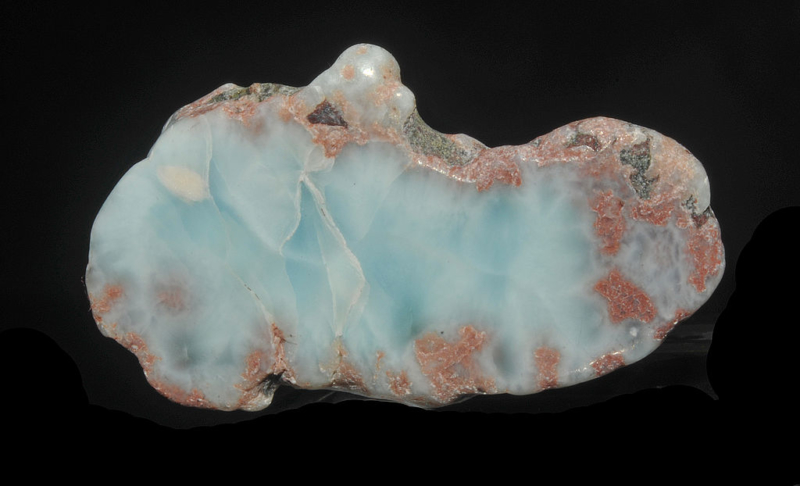
Parent Géry / CC BY-SA (https://creativecommons.org/licenses/by-sa/3.0)
BUT, the key point I’m trying to demonstrate here is that true-blue (pun always intended) larimar is MOSTLY blue. The very reason it has that Latin root “mar” in it describes it as blue.
What’s causing this “red larimar” confusion is an allegedly new red-colored pectolite find from South Africa that some sellers have taken to classifying as “Red Larimar”. Ummm, no. It’s a red pectolite.
Plain and simple.
Yes, blue Larimar is a pectolite (a type of silicate mineral), but it’s the blue variety with its own name. The red pectolite mineral has a completely different energy imprint than larimar. So, saying this red pectolite is “Red Larimar” is like saying smokey quartz is “brown amethyst” because both amethyst and smokey quartz are both quartz. No, it’s smokey quartz. It has a different chemical makeup, a different way that it was “baked” in Mama Earth, and a completely different energetic signature to it.
So, I definitely classify “red larimar” as a total misrepresentation; simply a new confusing term on the market taking advantage of the fact that it’s of the same mineral family. Geez, if we’re gonna go that route, there’s going to be a whole lot more confusing mineral representations coming down the pike! Let’s just put the brakes on this sorta thing now.

What in the hell?
There’s so much wrong with this above listing title, I don’t even know where to begin!
Fake Ametrine
Ametrine is quite visually as well as energetically appealing because it contains the properties of both amethyst + citrine in one crystal. Fascinating, right?!
So from a geological description; its a single crystal with both amethyst and citrine color zones; obviously where it gets its name from.
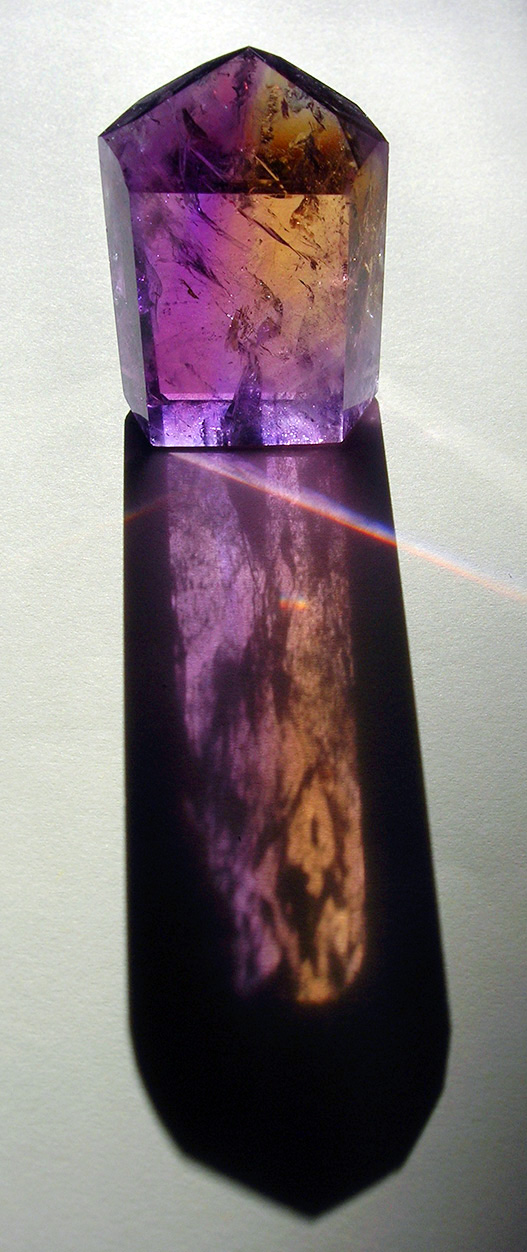
Prices should be high for a natural piece since they are EXTREMELY RARE and only are found in Bolivia (from the Anahí mine) and they’re quite difficult to mine.
BE AWARE: In the ’80s, scientists figured out how ametrine crystals develop in nature. And with that info, they became quite successful at replicating the process in the lab. Most of the ametrine on the market is synthetic, lab-created in Russia. Here’s all the info on that.
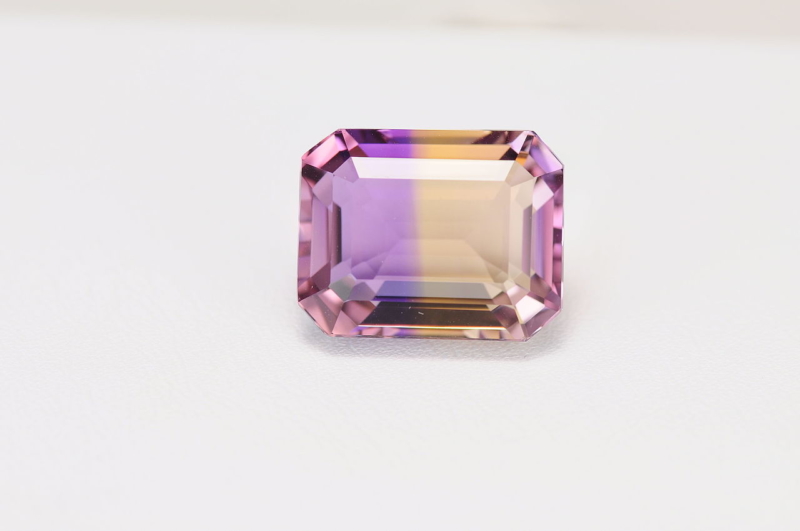
Gemsphoto (www.finesell.ru) / CC BY-SA (https://creativecommons.org/licenses/by-sa/3.0)
I wish I could give you some easy testing methods to ID this fake stuff but you’d need some super-advanced x-ray techniques + expensive gemological equipment. If you still wanna totally geek out on HOW to do that, here you go.
CAUTION: At first I used to think to myself: “If you really want a piece of ametrine in your collection, locate a totally natural crystal point. It’s not a guarantee but the odds are much better that it’s gonna be natural than a cut, faceted gemstone.” But since, I’ve learned that even with a natural-looking ametrine crystal point, it’s still possible for someone to synthetically apply a process or lab-grown it to fake the separate color-zoning and mimic genuine ametrine.
It’s a total shame — but I just can’t trust ANY of the ametrine on the market to be natural at this point.
Bottom line is: seems that MOST of the ametrine for sale out there is indeed fake.
Fake Malachite
Wait! What? They’re faking malachite now?
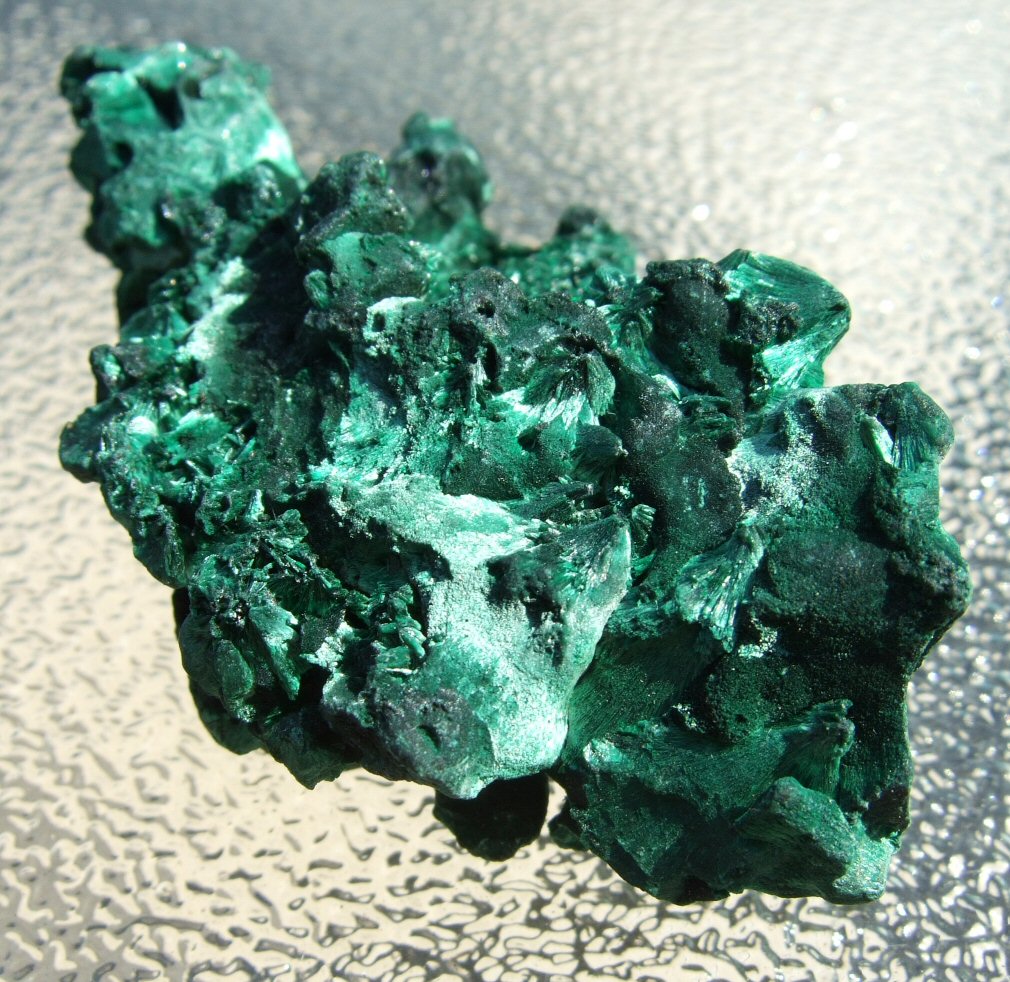
REAL: All-natural fibrous malachite is hard to fake

FAKE: See how we only have two shades of green swirled (not botryoidal-patterned by the way!) with black? Clearly fake! And this was being sold on eBay as natural malachite.
Actually, this fake malachite racket’s been going on for a while because it’s one of the easiest minerals to mimic while fetching a good price; good ole’ greed. As long as it’s labeled as “fake, synthetic, faux” or the like then I have no problem with this. But don’t try to pass this stuff off as the real thing!
Then there’s also “Red Malachite” that I blogged about before.
Quick ID Tips:
- Depending on the angle the malachite is cut or broken off at, it may display a very complex botryoidal pattern (circular, bubbly pattern — see below photo) that’s quite hard to replicate.
- A cheap price = a red flag. Real malachite ain’t cheap. Of course, this is no guarantee but it’s something to pay attention to.
- Usually, a streak test will ID genuine malachite for you. It will leave behind a pale green powdery streak on a porcelain tile. If you want to get all geo-geeky with me, there are some more “involved” but easy-to-do at-home tests I teach in my Crystal Savvy Class Elective.
- Oftentimes, the fake malachites (be especially careful with beads!!) are made of glass, polymer clay, plastics, resins, or any combo of any of those with various dyes swirled in. (Often these swirls and bands will be almost black; a key indicator of a fake! Actually, any black is usually a clear fake-flag. Real malachite is made of up many hues and tones of green, not just 2 or 3 shades plus black, as fakes often have.)
- If it’s a plastic/resin combo, then it will burn when you hold a flame up to it, and it’ll stink!
- Also, compare its weight to a similar in size natural piece. Malachite is quite dense and weighty due to its copper content. Whereas the glass, polymer, or plastic fakes will be relatively light.
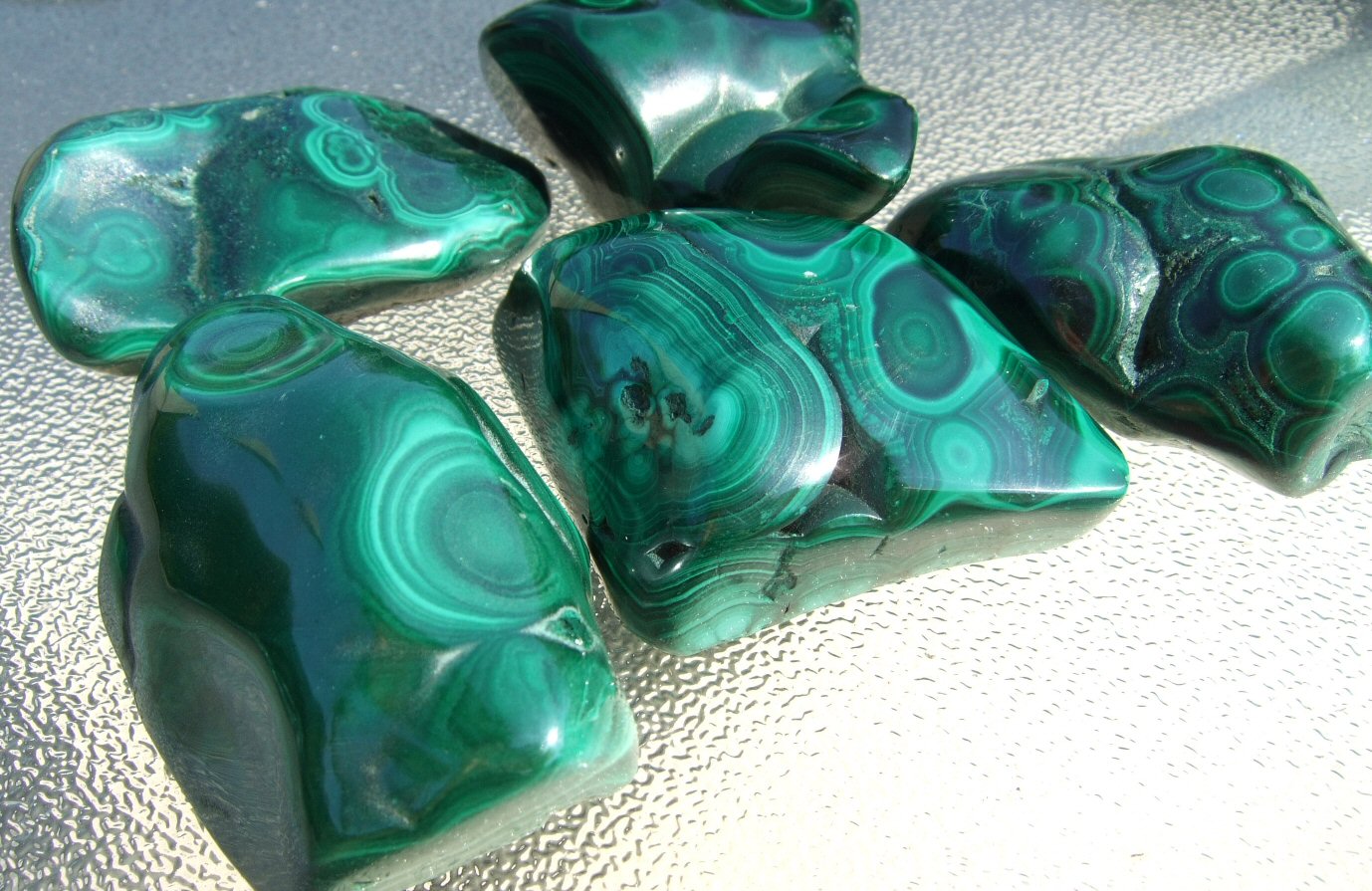
Smoothed + polished but REAL malachite. Note all the many shades of green and absence of black? Plus very complex botryoidal (circular) markings? All tell-tale signs of the real deal. 🙂
Do Your Thing
Can you tell I’m a wee bit passionate about crystal fakes?
Now, if you choose to work with man-made crystals and you enjoy them just fine, or it’s been working for you… as I always say:
“keep on ‘truckin’”. Don’t change a thing!
I just want us all to have the geo-knowledge first. Then you can make a well-informed decision regarding how you choose to work with these “stones”. Always use your common sense and the best protection from this is to be well-informed yourself.
And as always…
Buyer Beware: Who are you buying from? Are they reputable? Do they know what they’re talking about? Are you doing your own due diligence + research? The best way to protect yourself is through education.
We all love the beautiful jewels that mama earth creates and you don’t know what you don’t know… until you know better. So, I hope you’ve learned something new here today. If you feel passionate about this too, please share this post in any way you prefer. (***There are some handy “SHARE” buttons you can use at the bottom of this post***).
Have you seen any of these or new crystal fakes or misrepresentations recently? Please share in the comments below!
Crystal Blessings,


Thank you for this very informative and invaluable piece of information .
Always my pleasure, Maree. 🙂
Larimar was not called that by the natives- they called it something that translates in English to “blue stone” but “mar” is a Spanish word and the natives did not speak Spanish. Larimar was named by Miguel Mendez who named it “Lar” (for his daughter Larissa) “i” (and) “mar” (Spanish word for sea).
So true, Lydia! Do I need to correct that in my larimar post?
Yes Lydia the Taíno or Arahuaco most definitely didn’t speak Spanish at least not until the conquistadors came and enslaved them. Hibiscus Moon ???? I would definitely change that. Accuracy and cultural sensitivity matters.
OK, I needed to correct that bit of info in this very post. So I went ahead and did that. Thank you for bringing that slip-up to my attention, Lydia and Ursula. ♥
98% of the fakes are coming out of China. I’ve had several Chinese “wholesalers” send me glass instead of quartz (just test it against written text – quartz does not magnify the text, glass will) and other lab grown crystals. Just don’t buy from chinese “wholesalers” online. Find a reputable dealer in the U.S.!!
Hey T! <<(just test it against written text – quartz does not magnify the text, glass will)>> Oooo, that’s a handy testing method. Great share!! ♥
What if the quartz is a polished stone, mine magnifies. So is it glass. I’m reading all kinds of stuff and getting pretty frustrated.
Omgoodness you gorgeous goddess you✨????✨…I really appreciate this information…Im pretttttty sure that I may have actually just recieved 2 pieces of fake ametrine, both from the same shop and as part of an Etsy shops crystal “prescription” kits ???? the kits were not super expensive but definitely not cheap either. Probably I think about 40 to 50 but there was also 6 other stones. It really sucks that people are out there selling fake crystals as the majority of people purchase them due to health conditions and comfort and healing…basically the most vulnerable of our society. The worst part is that I’m on disability so am only able to get myself a little gift on my birthday or around holidays of I received money or cheque and crystals along with all things natural are literally my medicine. I don’t understand how people could do this to others let alone people to the most vulnerable!!! I generally have a good sense of authenticity but it’s hard to get that with the way the setup their pictures I guess. I have alot of crystals from different places over the years but I don’t know really feel them providing my with the health part. But I often wonder why that happens.m..as in chakra blockages and whatnot. I will definitely pass along this information…including yours also spirit sista!! ????✨????
Oh yes!!!! I almost forgot to ask you ( as long as it’s ok to ask)
But Besides your stunning shop of course ????✌️????✨ are there any other trustworthy online shops that you would trust or know about that won’t/don’t believe in selling fakes please be thankyouuuu? Or maybe there’s a list? I shop alot on Etsy for my crystals just so you know and live up in Nova scotia Canada…I have several autoimmune diseases (mixed connective tissue disease fibro lupus MS and lots of other fabulous health conditions just so you know but I’m a warrior ☺️ 8e love to hopefully chat with you sometime soon!! ????✨????✨???? Thanks for everything you do and have an absolutely amazing day and weekend!!!!
Hey, Ash, I don’t sell crystals. 😉 And I don’t endorse any particular crystal shop. I can only tell you what I do … usually, I buy my crystals in person at the gem shows. Often times, crystal sellers are not out there to purposely dupe their customers. They’re just passing on the info they trust from who they purchase from. As you can see here, you can’t just TRUST. We all need to be educated and work and being lifelong learners and to continually research and stay up on the latest if you’re going to take on the responsibility of stone selling. I feel strongly about that… obviously. 😉 For buying online, look for LOTS of good recommendations and reviews from others (especially with the most recent reviews from the last year). Healing Blessings to you and Much Love, Babe! ♥
To Ash S., Just a thought to pass along about your not “feeling” the health benefits from crystals. This is my belief : most of us get caught up in buying crystals in jewellery form that have a backing of some kind to hold it in place. I have stopped buying these types because I need to have the crystal fully touch my skin in order to receive the benefits they have( How can they heal us with their energy if they are all wrapped up in ‘ bells and whistles’ and the extra cost you have to dish out) Plus do you clear them and charge them frequently ( check which ones not to use water with)? Plus I get quite annoyed with bracelets made of crystals because most don’t work placed or worn on the wrists. Also a major factor is you must energize your crystals by Dedicating them with love and light first, then to Program them with an intention. Also if you place Reiki symbols in them that is a huge benefit! Sometimes even the raw form (not polished) of crystals are better suited for an ailment. Just from my perspective.
Hi, ASH S.! You and I seem to be in similar situations regarding health, financial, and being on Disability, which sucks all by itself. Like you, I also collect CRYSTALS both for their beauty and their benefits! I may have some ideas that could help with your inflammation issues from some of your conditions so I wanted to reach out and let you know you can find me on Facebook and Facebook messenger to get in contact with me. I have dealt with Rheumatoid Arthritis myself for almost 12 years, my daughter has Fibromyalgia almost 4 years (she’s 18) and my husband has arthritis in his knees, his back, and has massive pain in his right shoulder, from 9 surgeries that led to fusing the joint. So you see, I’ve done loads of research and playing around with different “methods” of different crystal healing and medical options for many health conditions! Simply willing to help a fellow sufferer of “body rebellion” as I call it! Write me anytime 🙂
I’ve been wondering if some of the Ametrine on the market could be created by using a heat laser on natural Amethyst? I have seen some beautiful but polished Ametrine points from Bolivia, which I think might be natural after reading this. Thank you
Hey Ethan! I didn’t notice a mention of laser but maybe I missed that part?
Thank you so much for always being an advocate for us crystal folk. We love you for it!
I’m so happy to do it, Alyse. I love you for being a part of it. ♥
Hi Hibiscus Moon
Thank you for this I have this crystal and my is real in a necklace. I have always before taking you CCP classes. watch a lot of your videos. And the reason I took your classes is because HM you tell it like it is.
Thanks again and Crystal Blessing to you and your wonderful Team!!!!
Thank you so much for being a valuable member of our community, Veronica. ((HUGS))
Hi great article can Super Seven be fake? I’m really drawn to buying a piece. But it’s expensive so I don’t want to be duped
Thank you
Sharon ????❤️????
If Lapis Lazuli has a milky sheen under uv/ black light it’s genuine
Do you recommend a website that I can purchase real crystals??? I don’t see any for sale on your website or am I missing it??